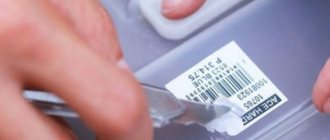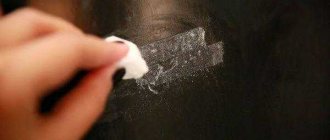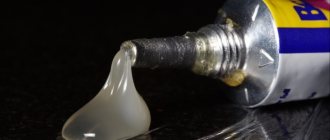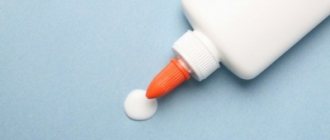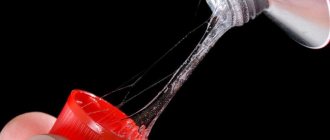Many things and goods, including books, household and electronic appliances, dishes, cars, have a manufacturer's label or barcode, and sometimes a price tag. Often these stickers are located in the most inappropriate places and spoil the appearance of the products.
However, removing the label is not so easy, since they are glued with high-strength adhesive. This is done so that the sticker does not fall off during transportation and transportation of the goods.
Typically, label removal is done mechanically, when the sticker is pryed with a fingernail or a sharp object and an attempt is made to pick it off. However, often the glued label is removed only in small pieces, leaving particles on the surface, despite the applied efforts.
In addition, after removal, unsightly marks from stickers, paper or glue remain on the products. And sharp objects can scratch things.
In this article we will look at how to peel off a sticker without leaving marks or harming things. The method of removal depends on the type and type of product. Some methods are used for plastic, others for books, and so on.
You cannot use products designed to clean one material on another, otherwise you will ruin the thing! Next, we will learn how to remove stickers from various products. And let's look at how to remove traces of glue and paper from the surface of objects.
How to remove glue from a sticker from plastic
Peeling off a sticker without leaving a trace at home is quite simple.
To ensure that the label sticks tightly and does not come off, manufacturers use strong adhesive . Removing it is quite difficult; you will need auxiliary materials and chemicals.
A few simple remedies:
- Chemical solvent for paints and varnishes . The plastic is immersed in the solvent for 5-7 minutes. During this time, the adhesive base will completely soften and will not be sticky. Residues are removed with a plastic scraper. The procedure should be carried out with gloves, and upon completion, wash your hands thoroughly.
- Ethyl and medical alcohol . At the pharmacy you buy a solvent of 92 or 96%. It perfectly “removes” glue residues from plastic. To do this, dampen a clean rag and wipe the stain. After some time, the adhesive base curls up and dissolves. Residues are removed with a new, clean rag or washcloth.
- Acetone or nail polish remover . The solvent is applied using a small piece of cloth. Wait a few minutes until the label gets wet and remove it.
- Vegetable oil . Place an item with a sticker in the container with the product and wait 12-15 minutes. The base is impregnated with vegetable fats, after which it is easy to remove with a blade.
- Paste. Add a small amount of soda to the water until a thick mass is formed. It is applied for a few minutes, then removed with a washcloth or cloth along with the glue.
To quickly remove glue, use a technical aerosol. You can buy it at a hardware store.
Branded products
In our industrial age, store shelves are full of a variety of chemicals. They also contain natural environmental substances. This is good, it does not harm the foundation.
- "Antiscotch" is a universal one. Cleans everything.
- Fine Glass. For glass. But knowledgeable people advise using it for ceramics, plastic and metal.
- Scotch Remover with citrus oils. Removes adhesive pastes, resins, tar.
- Liqui Moly. Natural material.
The only thing you may not like about these products is the high cost.
How to remove label glue from glass
You should remove the sticker from glass objects before the first wash.
If the paper is difficult to remove, the following will help:
- Hair dryer. The procedure will take a few minutes. A hot air stream is directed onto the sticker. After a while it will begin to lag behind the glass. It is pryed off with a sharp object, and the glass or porcelain is washed in running water.
- Steam. The water is boiled and the glass container is held over the steam. The procedure lasts 5-7 minutes. The sticker peels off when exposed to hot air. When finished, rinse with hot water and soap.
- Boiling water. Soak cutlery with soap or detergent. When the label gets wet, remove it with a knife or metal sponge.
Read more ► How to adjust plastic windows so that they close tightly and do not blow in winter and summer
Baking soda will help at home - it can easily remove the sticker. To do this, apply a small amount of bicarbonate and remove it with a scraper.
How to remove stickers from dishes and porcelain
Removing the adhesive layer from dishes is quite difficult.
Removing the adhesive layer from dishes is quite difficult. At home you will need available materials.
Various options are used for this:
- Cologne. The alcohol solvent is applied using gauze or a cloth. Leave for 20 minutes. When the adhesive base gets wet, it is removed with dishwashing detergent. If there is no cologne in the house, use vodka.
- Vegetable oil . The dishes are soaked in water for several minutes, the sticky part is greased. Leave for one hour. Residues are removed with a washcloth and washed under water. The oil is washed off with cleaning powder or detergent.
- Vinegar. The dishes are soaked in vinegar and removed for one hour. Afterwards, the sticker is removed with a scraper, and the porcelain or glass is thoroughly washed.
You can remove glue from glass with a steel wool or knife. Don't be afraid to damage the surface. The dishes are “not afraid” of mechanical and chemical influence.
How to remove stickers from books
Buy a specialized stationery solution for paper. The
following will help you remove labels from a printed publication:
- Scotch. After removing the sticker, any remaining adhesive can be carefully removed using adhesive tape.
- Iron . The book is covered with a thick cloth and ironed. Under the influence of temperature, the label can be easily removed from the paper.
- Solvent. Use nail polish remover, but without acetone. The glue stain is wiped off with solvent. This method is suitable for glossy covers.
If these methods do not help , buy a specialized stationery solution for paper. It will easily remove the adhesive surface.
Some useful tips
Check out these helpful tips:
Before deciding on the chosen method for removing adhesive residue, it is important to take into account the type of material and type of item. For example, it is necessary to remove glue from electronics. In this case, use water and oil with extreme caution.- It's best to treat a small area first before cleaning the entire surface.
- Work should be carried out in protective clothing, wearing gloves or even special glasses to avoid getting the substance into your eyes. It is advisable to have an influx of fresh air and open the window.
- If you use a hair dryer or iron, you must also take appropriate precautions to avoid getting burned.
As you can see, cleaning the surface from stickers or traces of glue is not at all difficult, you just need to use simple tips and show a little patience.
How to peel off a sticker from a soft surface
Manufacturers use barcode markings on the upholstered surface of furniture, fabric or finished textile products.
For cleaning, use special solvents or pure gasoline. The substances degrease the surface of the paper, after which the adhesive base is washed off with a soap solution.
Heat is used for fabric. The hairdryer is held for 7 minutes, then the sticker is removed with a knife. Use a clothes brush to remove any remaining glue and wash the fabric. The method is suitable for tablecloths, curtains and curtains.
Methods for cleaning different surfaces
Label glue sticks tightly into any material. Methods for removing it depend on the type of surface. Thus, plastic is not resistant to abrasion and mechanical cleaning. And you can’t use cleaning liquids on paper.
Clothing and fabrics
Traces of barcodes and tags made of paper remain on clothing. The fabrics are resistant to mechanical abrasion and can be wetted. It is not recommended to use solvents and acetone: they remove dyes from clothes, leaving behind stains.
You can remove glue from fabric by heating it. Turn the item inside out, apply gauze and iron over the contaminated area. When the glue gets wet, remove any remaining glue with a sponge or clean rag.
You can also heat the fabric with a hairdryer. There is no need to turn the clothes inside out or apply gauze. Direct a stream of warm air onto the glue and wait until it begins to “melt”. After heating, its residues are also removed mechanically. The hair dryer is used for thin synthetic fabrics that cannot be ironed with a hot iron.
Vinegar, vegetable oil, and acetone are also used to clean clothes from glue. Before applying them, the fabric is tested: the product is poured onto a small area to see if it will leave a faded stain.
Heat can be replaced with cold. The contaminated area is frozen rather than heated. In this case, the glue will crumble and roll off, but the fabric will not deteriorate under the influence of high temperatures.
Plastic
The glue adheres securely to the plastic, leaving a sticky layer on it. If it is fresh, it is washed with a damp cloth, brush or a hard, but not sharp, object. You can remove the glue from the sticker from the plastic by heating it with a hairdryer.
Dried glue is removed using gentle means:
- soap;
- boiling water;
- soda;
- gasoline.
If their use does not bring results, more aggressive compounds are used - acetone, alcohol and solvents.
Coarse abrasives should not be applied to plastic; do not rub it with hard sponges; they leave scratches on its surface.
Glass
Stickers and labels are attached to the glass with high-strength adhesive. It is not removed when wet, but when heated it turns into a sticky mass.
Stickers on cars and household appliances
Removing a label from a car is quite simple; for this you will need:
- household hair dryer;
- car cleaner;
- construction hairdryer (installed at gas stations and service stations).
Read more ► How to wash the outside of a window without streaks if it doesn’t open and you can’t reach it
When exposed to hot air, the paper peels off easily, and its sticky layer is removed with a plastic scraper . Do not use a metal sponge - it will scratch the car's paint.
Under the influence of hot air, the paper peels off easily, and its sticky layer is removed with a plastic scraper
To clean equipment use:
- oil: corn, olive, sunflower;
- cleaners;
- hairdryer
After completing the procedure, wash the devices with soapy water or dish soap. Cleaning methods that are used for plastic are also suitable for household appliances.
How to remove sticky adhesive from other materials?
To remove traces of glue, it is important to consider the material on which the sticker was glued. A variety of cleaning methods are used.
Tools used
The adhesive base can be removed manually using detergent.
If this does not help, then use:
- oil: sunflower, corn, olive;
- alcohol;
- vinegar;
- scotch;
- acetone;
- household hair dryer;
- citrus.
Oil
The method is suitable for surfaces that do not absorb fats.
Sequence of procedure:
- The label is soaked in oil and left for 10 minutes.
- Soaked paper is removed with a knife or plastic scraper.
- The product is washed with soap and water, and the remaining glue is removed.
If the house runs out of oil, you can take 20-40 g of mayonnaise.
Alcohol
Use pure homemade alcohol tincture
Use pure homemade alcohol tincture, store-bought vodka, deodorants.
Procedure:
- A cloth napkin is soaked in the composition.
- Wipe off the adhesive base.
- Rinse thoroughly with hot water.
This method is not suitable for all materials; you should first check it on an inconspicuous fragment.
Vinegar
Suitable for most surfaces, it does not contain “aggressive” chemicals.
Algorithm of actions:
- Apply table vinegar to a cloth.
- Wait 7-10 minutes: the paper will become limp during this time.
- Carefully remove the top layer.
- The glue is wiped with a wet cloth.
If the procedure does not help, repeat several times until the adhesive stain completely disappears.
Scotch
This method will help when the sticker is “fresh” and can be easily removed. Tape is glued to the top and torn off with a sharp movement.
The procedure is carried out several times, rinsing the remaining adhesive base with water.
Acetone
Solvent and a hair dryer will help in the fight against factory price tags. The label is heated with hot air and removed with a scraper. The remaining adhesive base is wiped off with a cloth soaked in acetone.
Hairdryer
Suitable for metal and durable materials.
Procedure:
- The surface is heated.
- They take off the price tag.
- Soak in oil or fat and leave for 10 minutes.
- Wash with detergent.
A household or hair dryer is suitable for warming up.
Citrus
You will need several lemons to remove the paper. The label is soaked in lemon juice and left for 10-20 minutes. The paper is removed with glue and washed with soap base.
Read more ► How to make window cleaner, recipe option at home
Removing stickers from clothes
Using an iron or hairdryer, heat the required area.
It is possible to remove price tags from items at home.
A few common options:
- Using an iron or hair dryer, heat the required area . A cloth is placed on the clothes so as not to spoil the surface. It is also necessary to read the composition of the fabric: some materials should not be subjected to heat treatment.
- Use nail polish remover without acetone. The sticker is carefully impregnated with it. But it’s worth checking first on an inconspicuous area of clothing, otherwise your favorite item may lose color.
- Clothes are placed in the freezer for 25-40 minutes. During this time, the glue “dries out” and the thermal pattern is easily removed by hand.
To remove the sticky layer, use tape, laundry soap and detergents.
From furniture and wood
The adhesive layer must be removed especially carefully if the furniture has a polished surface. Careless actions will lead to damage to interior items.
It is important to choose the right cleaning method:
- Heat treatment. The sticker is heated with a hairdryer for several minutes. The edge is lifted with a flat plastic object. Moisten a cloth with a polishing solution and wipe the surface of the furniture.
- Sunflower oil. The paper is moistened and left for several minutes. Scrub with a plastic object (knife). Furniture is wiped with soapy water.
- Aerosol . Spray on adhesive paper and leave for 2-3 minutes, then remove. It does not harm furniture and polishes the surface.
Old stickers are left for 10-15 minutes and soaked in alcohol.
From metal
Peeling the sticker off metal products without leaving a trace is not difficult. The methods listed above are suitable for this.
Means and materials for processing:
- hair dryer;
- vinegar;
- solvents;
- industrial products;
- oil;
- lemon juice.
- alcohol;
- alcohol.
The metal surface is durable and therefore difficult to damage.
Folk remedies for removing sticker marks
It's great if the label comes off easily. But under the paper we find an adhesive substrate. It should be removed. Let's see what we have at home.
Fat (oil)
There's probably butter in the refrigerator. It doesn’t matter what it is, whether it’s creamy or cosmetic. Don’t even disdain margarine and mayonnaise: anything will do. The fat will soften the glue in 10 minutes and can be easily scraped off with a soft plastic spatula; don’t even throw away the old plastic card, it will come in handy around the house.
Alcohol
Pure alcohol and alcohol-containing substances are effective as solvents. Moisten an old rag with the preparation and begin to quietly wipe off the sticky mass.
If you see that the layer there is thick, saturate it first. Instead of cotton wool, you can take universal napkins in rolls. Pharmaceutical alcohol is also suitable, but it will take a lot of them, this is not the most economical option. But if you need it quickly, this method will do.
Acetic acid
The most common vinegar, which is most often used in the kitchen, is a solution of synthetic 9% is enough. This is table vinegar.
- Wet the cloth generously and apply it to the problem area.
- After 15 minutes, clean with something other than a knife, otherwise you risk damaging the base.
- Now rinse with clean water and get to work.
- For plastic products, a different method is needed.
Steam
Depending on what you're cleaning, you might want to try steam. Not all items can withstand the high temperature created by a steamer, steam generator or a regular iron with a steam function.
Eraser or melamine sponge
Any student's normal school subject will serve you well. Just first soak the area with the remaining label in warm water and laundry soap for 15 minutes. And then, after wiping with a very hard cloth, continue this noble work with an eraser.
Melamine sponge is a foamed plastic that resembles sandpaper, so it acts like an eraser, but should not be used where there is a risk of scratching the surface. Let us remind you that it should not be used with utensils that come into contact with food.
These are the most effective means. But you can bring WD-40 grease cleaner and lighter fluid from the garage. Although, first try taking a slice of lemon from the kitchen or diluting citric acid from a bag.
